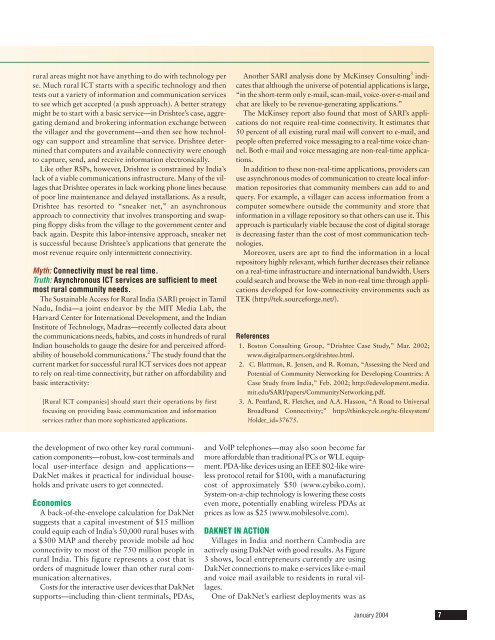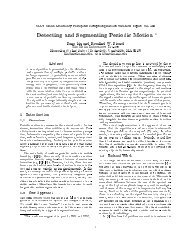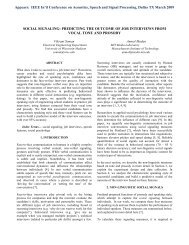DakNet: Rethinking Connectivity in Developing Nations - First Mile ...
DakNet: Rethinking Connectivity in Developing Nations - First Mile ...
DakNet: Rethinking Connectivity in Developing Nations - First Mile ...
You also want an ePaper? Increase the reach of your titles
YUMPU automatically turns print PDFs into web optimized ePapers that Google loves.
ural areas might not have anyth<strong>in</strong>g to do with technology per<br />
se. Much rural ICT starts with a specific technology and then<br />
tests out a variety of <strong>in</strong>formation and communication services<br />
to see which get accepted (a push approach). A better strategy<br />
might be to start with a basic service—<strong>in</strong> Drishtee’s case, aggregat<strong>in</strong>g<br />
demand and broker<strong>in</strong>g <strong>in</strong>formation exchange between<br />
the villager and the government—and then see how technology<br />
can support and streaml<strong>in</strong>e that service. Drishtee determ<strong>in</strong>ed<br />
that computers and available connectivity were enough<br />
to capture, send, and receive <strong>in</strong>formation electronically.<br />
Like other RSPs, however, Drishtee is constra<strong>in</strong>ed by India’s<br />
lack of a viable communications <strong>in</strong>frastructure. Many of the villages<br />
that Drishtee operates <strong>in</strong> lack work<strong>in</strong>g phone l<strong>in</strong>es because<br />
of poor l<strong>in</strong>e ma<strong>in</strong>tenance and delayed <strong>in</strong>stallations. As a result,<br />
Drishtee has resorted to “sneaker net,” an asynchronous<br />
approach to connectivity that <strong>in</strong>volves transport<strong>in</strong>g and swapp<strong>in</strong>g<br />
floppy disks from the village to the government center and<br />
back aga<strong>in</strong>. Despite this labor-<strong>in</strong>tensive approach, sneaker net<br />
is successful because Drishtee’s applications that generate the<br />
most revenue require only <strong>in</strong>termittent connectivity.<br />
Myth: <strong>Connectivity</strong> must be real time.<br />
Truth: Asynchronous ICT services are sufficient to meet<br />
most rural community needs.<br />
The Susta<strong>in</strong>able Access for Rural India (SARI) project <strong>in</strong> Tamil<br />
Nadu, India—a jo<strong>in</strong>t endeavor by the MIT Media Lab, the<br />
Harvard Center for International Development, and the Indian<br />
Institute of Technology, Madras—recently collected data about<br />
the communications needs, habits, and costs <strong>in</strong> hundreds of rural<br />
Indian households to gauge the desire for and perceived affordability<br />
of household communications. 2 The study found that the<br />
current market for successful rural ICT services does not appear<br />
to rely on real-time connectivity, but rather on affordability and<br />
basic <strong>in</strong>teractivity:<br />
[Rural ICT companies] should start their operations by first<br />
focus<strong>in</strong>g on provid<strong>in</strong>g basic communication and <strong>in</strong>formation<br />
services rather than more sophisticated applications.<br />
Another SARI analysis done by McK<strong>in</strong>sey Consult<strong>in</strong>g 3 <strong>in</strong>dicates<br />
that although the universe of potential applications is large,<br />
“<strong>in</strong> the short-term only e-mail, scan-mail, voice-over-e-mail and<br />
chat are likely to be revenue-generat<strong>in</strong>g applications.”<br />
The McK<strong>in</strong>sey report also found that most of SARI’s applications<br />
do not require real-time connectivity. It estimates that<br />
50 percent of all exist<strong>in</strong>g rural mail will convert to e-mail, and<br />
people often preferred voice messag<strong>in</strong>g to a real-time voice channel.<br />
Both e-mail and voice messag<strong>in</strong>g are non-real-time applications.<br />
In addition to these non-real-time applications, providers can<br />
use asynchronous modes of communication to create local <strong>in</strong>formation<br />
repositories that community members can add to and<br />
query. For example, a villager can access <strong>in</strong>formation from a<br />
computer somewhere outside the community and store that<br />
<strong>in</strong>formation <strong>in</strong> a village repository so that others can use it. This<br />
approach is particularly viable because the cost of digital storage<br />
is decreas<strong>in</strong>g faster than the cost of most communication technologies.<br />
Moreover, users are apt to f<strong>in</strong>d the <strong>in</strong>formation <strong>in</strong> a local<br />
repository highly relevant, which further decreases their reliance<br />
on a real-time <strong>in</strong>frastructure and <strong>in</strong>ternational bandwidth. Users<br />
could search and browse the Web <strong>in</strong> non-real time through applications<br />
developed for low-connectivity environments such as<br />
TEK (http://tek.sourceforge.net/).<br />
References<br />
1. Boston Consult<strong>in</strong>g Group, “Drishtee Case Study,” Mar. 2002;<br />
www.digitalpartners.org/drishtee.html.<br />
2. C. Blattman, R. Jensen, and R. Roman, “Assess<strong>in</strong>g the Need and<br />
Potential of Community Network<strong>in</strong>g for Develop<strong>in</strong>g Countries: A<br />
Case Study from India,” Feb. 2002; http://edevelopment.media.<br />
mit.edu/SARI/papers/CommunityNetwork<strong>in</strong>g.pdf.<br />
3. A. Pentland, R. Fletcher, and A.A. Hasson, “A Road to Universal<br />
Broadband <strong>Connectivity</strong>;” http://th<strong>in</strong>kcycle.org/tc-filesystem/<br />
?folder_id=37675.<br />
the development of two other key rural communication<br />
components—robust, low-cost term<strong>in</strong>als and<br />
local user-<strong>in</strong>terface design and applications—<br />
<strong>DakNet</strong> makes it practical for <strong>in</strong>dividual households<br />
and private users to get connected.<br />
Economics<br />
A back-of-the-envelope calculation for <strong>DakNet</strong><br />
suggests that a capital <strong>in</strong>vestment of $15 million<br />
could equip each of India’s 50,000 rural buses with<br />
a $300 MAP and thereby provide mobile ad hoc<br />
connectivity to most of the 750 million people <strong>in</strong><br />
rural India. This figure represents a cost that is<br />
orders of magnitude lower than other rural communication<br />
alternatives.<br />
Costs for the <strong>in</strong>teractive user devices that <strong>DakNet</strong><br />
supports—<strong>in</strong>clud<strong>in</strong>g th<strong>in</strong>-client term<strong>in</strong>als, PDAs,<br />
and VoIP telephones—may also soon become far<br />
more affordable than traditional PCs or WLL equipment.<br />
PDA-like devices us<strong>in</strong>g an IEEE 802-like wireless<br />
protocol retail for $100, with a manufactur<strong>in</strong>g<br />
cost of approximately $50 (www.cybiko.com).<br />
System-on-a-chip technology is lower<strong>in</strong>g these costs<br />
even more, potentially enabl<strong>in</strong>g wireless PDAs at<br />
prices as low as $25 (www.mobilesolve.com).<br />
DAKNET IN ACTION<br />
Villages <strong>in</strong> India and northern Cambodia are<br />
actively us<strong>in</strong>g <strong>DakNet</strong> with good results. As Figure<br />
3 shows, local entrepreneurs currently are us<strong>in</strong>g<br />
<strong>DakNet</strong> connections to make e-services like e-mail<br />
and voice mail available to residents <strong>in</strong> rural villages.<br />
One of <strong>DakNet</strong>’s earliest deployments was as<br />
January 2004 7






